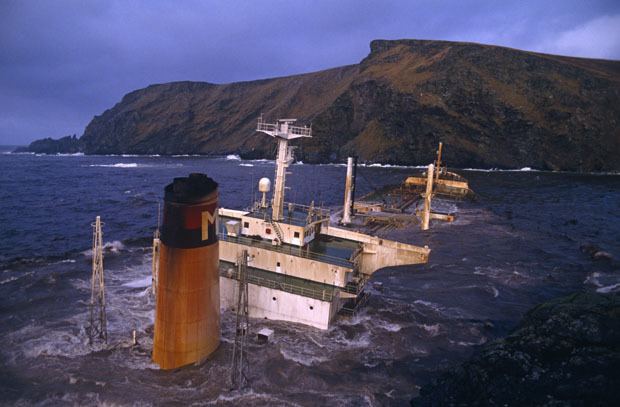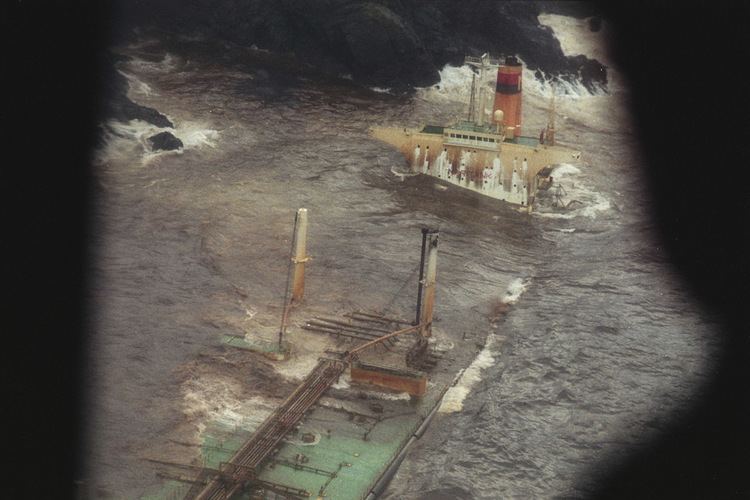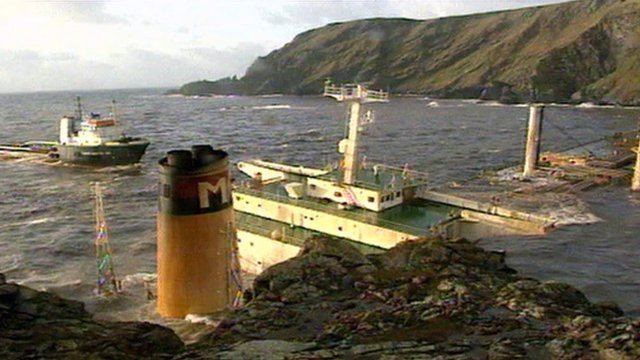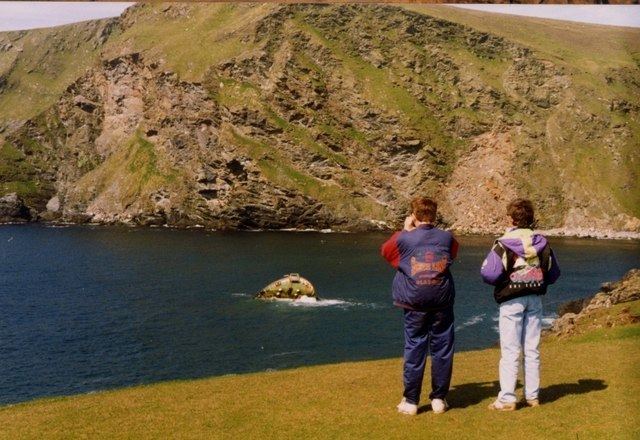Name Braer Operator Canadian Ultramar Ltd Launched 1975 Beam 40 m | Owner Braer Corporation Length 242 m | |
 | ||
Fate Ran aground near Quendale, Shetland, Scotland, in 1993 | ||
Mv braer
The MV Braer was an oil tanker which ran aground during a storm off Shetland, Scotland, in January 1993, and nearly a week later broke up during the most intense extratropical cyclone on record for the northern Atlantic ocean.
Contents
- Mv braer
- Reason for ships loss
- Timeline
- Environmental consequences
- Response
- Designation under the Protection of Wrecks Act 1973
- Memorial
- References

Reason for ship's loss

During the enquiry after the ship's loss, it was stated that the ship lost power due to seawater contamination of the ship's diesel fuel oil on 3 January. This occurred after a pipeline on the deck broke loose, allowing seawater to enter the engine. The loss of power caused the crew to lose control of the ship during a storm.
Timeline

At 05.19 hrs on Tuesday 5 January 1993, Lerwick coastguard were advised that the tanker, Braer, en route from Bergen, Norway to Quebec, Canada, laden with 85,000 tonnes of Norwegian Gullfaks crude oil, had lost engine power but was in no immediate danger. Her estimated position then was 10 miles (19 km) south of Sumburgh Head and she was drifting in predominantly southwesterly winds of force 10–11. The coastguard alerted rescue helicopters from Sumburgh and RAF Lossiemouth, and made enquiries about the availability of local tugs. At the Coast Guard's suggestion, the master agreed that non-essential personnel should be removed from the vessel—14 of the 34 crew were taken off by the coastguard helicopter from Sumburgh at 08:25.

At 08:50 it was feared that the ship would founder near Horse Island, and the experience of Aegean Sea which burst into flames shortly after grounding led the coastguard to persuade the Greek Captain Alexandros S. Gkelis to abandon ship. However, because of strong northwest local currents, Braer moved against the prevailing wind and missed Horse Island, drifting towards Quendale Bay.

With the arrival on scene of the anchor handling vessel Star Sirius, it was decided to attempt to establish a tow. The master and some personnel were taken out by helicopter and were put back on board the vessel. Efforts to attach a heaving line were unsuccessful, and at 11:19 the vessel was confirmed as being grounded at Garths Ness, with oil being seen to flow out into the sea from the moment of impact. At this time, the would-be rescue team were rescued by the helicopter.
Environmental consequences

Fortunately for Shetland, the Gulfaks crude Braer was carrying was not a typical North Sea oil. Gulfaks crude is lighter and more easily biodegradable than other North Sea crude oils, and this, in combination with some of the worst storms seen in Shetland (naturally dispersing the oil by wave action and evaporation), prevented the event becoming an even bigger disaster. The following is a brief account of the spread and eventual dispersion of the oil.
Response

The initial response, fuelled by intense media coverage over the new year holiday when news is in short supply, focused on wildlife rescue. The various local organisations that are involved in the wildlife aspects of a large oil spill had for some time planned how to cope with such events. Immediately after Braer grounded, these organisations (under the umbrella of the WRCC), representing the SIC, Sullom Voe Terminal (SVT), Scottish Natural Heritage (SNH), Shetland Oil Terminal Environmental Advisory Group (SOTEAG), Royal Society for the Protection of Birds (RSPB), Scottish Society for Prevention of Cruelty to Animals (SSPCA), and the Hillswick Wildlife Sanctuary, came together to initiate a response at the Boddam Scout hut (it having been identified as a suitable wildlife response "command centre"). From there, they directed all activities relating to wildlife affected by the spill; which was channelled into three categories:

- Organise teams to walk beaches and collect oiled birds and other animals
- Deal with live oiled birds and mammals
- Record and store dead birds and mammals
The volunteer response from the people of Shetland to walk beaches was excellent, especially considering the appalling weather conditions during much of January. From outside Shetland came several "walk-in" helpers, a team of five from the Scottish Wildlife Trust and two from British Gas, while some staff members from organisations such as the RSPB came north and helped out both on beaches and in key duties at the WRC. Volunteers were organised into teams of at least two and collected all dead and any live birds and animals from accessible beaches. Where possible, beaches were checked at least twice per day.
During the first few days of the spill, efforts were concentrated in the south-west Mainland, from Sandwick round to Maywick; but the northward spread of the oil up the west side meant that, by 12 January, surveys had been extended to cover the longer stretches of accessible coastline in the Burra, Scalloway, Whiteness and Weisdale areas, and westwards as far as Culswick. In total, all the accessible beaches from Leebitten (east Mainland) round Sumburgh to the Dale of Walls (west Mainland) were checked during the course of the spill, which prompted the setting up of a forward "command post" at Holmsgarth, Lerwick from where surveys of the "northern" coasts were co-ordinated.
By 26 January focus had shifted from wildlife rescue to human health, economic and ecological issues, and the Secretary of State for Scotland announced the establishment of an Ecological Steering Group to co-ordinate the environmental assessment. This was chaired by Professor William Ritchie of Aberdeen University, and its membership included Dr John Davies of the Marine Laboratory, Aberdeen; Martin Hall the Director of Environmental Services of Shetland Islands Council; Dr Paul Kingston of Heriot-Watt University; Dr Patricia Monaghan, a zoologist from Glasgow University; Professor Michael Usher, the Chief Scientific Adviser to Scottish Natural Heritage; Dr John Miles, the Ecological Adviser to the Scottish Office; and Bobby Tulloch MBE, a Shetland naturalist and author.
The total number of dead birds recovered from beaches during January was 1538. Of these, 805 (52%) were found between Sumburgh Head and Garths Ness. Only 60 corpses (3.8%) were collected from beaches along the east coast, with the remainder scattered fairly evenly along the west coast between Spiggie and Sandsound, with smaller numbers further north and west to Dale. During the first week of the spill (6–12 January), very few dead birds were found away from the area between Scatness and St. Ollie's Isle, and even in this area the majority were collected from the West Voe of Sumburgh, Scatness and Quendale. In the second week (13–19 January), fewer corpses were collected close to Braer, and there was a corresponding increase in the number collected from further north on the west coast. This trend continued into the third week (20–26 January), but, by the fourth week (27–31 January), very few birds were found anywhere and there was no obvious tendency for more to be found in one area than another.
In any oil spill, it is difficult to estimate the proportion of the actual mortality found on beach surveys, and several factors made that even harder in the case of Braer. The almost constant storms made it difficult to search shorelines as thoroughly as could have been done in calmer weather, and also made it much more difficult to catch live birds, some of which were driven inland by the wind. The weather also prevented systematic searches of the islands in Quendale Bay and further north, where birds were likely to have come ashore and died, while the exceptionally high tides at the time also compounded the problem, especially if they occurred in the middle of the day. For several days, beaches were completely under water for the 6–7 hours of daylight available for surveys, with unreachable corpses moving back and forth in the surf. When tides did drop, many beaches had been completely rearranged, or buried in tonnes of kelp by the heavy seas.
At Scatness, dead shags had been driven deep into cracks and crevices in the rocks or buried beneath the kelp, and sometimes just parts of a bird were found. In addition, the many small boulder beaches along the south-west coast were too inaccessible to be checked at all, several corpses were likely to have been scavenged by the larger gulls, and an unknown but almost certainly significant proportion will have been swept out to sea.
The Steering Group published an interim report in May 1993 and a final report in 1994, which contains details of the monitoring strategy and methods. It found that:
The Steering Group concluded that although there were local and limited adverse effects the overall impact of the spill had been minimal.
Designation under the Protection of Wrecks Act 1973
A designation under section 2 of the Protection of Wrecks Act was made on 8 February 1993. This part of the act is used to designate wrecks categorised as dangerous. It was only the second time that Part 2 of the Act was used to designate a wreck site, and the designation was imposed because of the presence of the oil. The designation was revoked on 7 October 1994 following dispersal of the oil.
Memorial
In 1995, British folk-rock band Fairport Convention released the album Jewel in the Crown, including "The Islands" by Ralph McTell and Maartin Allcock. The song commemorates the wreck of Braer, personifying the sea as the protector of the Shetland Islands.
